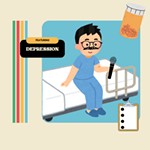Book Review: Readings
Part manifesto, part memoir, Robert Jensen's book calls on men to reject pornography, join the feminist movement, and rise above preconceived notions of sexuality
Reviewed by Terry Ornelas Woodroffe, Fri., Dec. 7, 2007

Getting Off: Pornography and the End of Masculinity
by Robert JensenSouth End Press, 197 pp., $12 (paper)
Pornography: A Groundwork Guide
by Debbie NathanGroundwood Books, 144 pp., $15.95
In his part-manifesto/part-memoir Getting Off: Pornography and the End of Masculinity, Robert Jensen asserts that, from a young age, boys are conditioned to repress sensitivity and be sexually aggressive in order to prove their manhood. Jensen, a UT associate professor of journalism, believes this "king of the hill" mentality is a societal construct and that pornography continues to reaffirm it. He tasks men to look to the root of their excitement when viewing pornography and to see how sexual power as represented on film carries into life. He refers to this "mirror" as one men are hesitant to look into, because facing it means facing the harmful mechanism of masculine control – control over themselves and over the women whose bodies are abused to access it.

To illustrate, Jensen graphically describes gang bangs, double penetrations, and violent fellatio. This is meant for readers to see that what lies behind the proverbial green door does not disappear when the viewer does. He dismisses pro-porn arguments about choice, dismisses even the idea that the performing woman truly has one. He feels the movement of mainstream pornography toward extremism should alarm society and that "recognizing that we live in a rape culture" is crucial. That pornography, through this maze of social stigmata, "reinforces the ideology in men's minds that all women are whores." He finishes this manifesto with a call to men to reject pornography, join the feminist movement, and rise above preconceived notions of sexuality.
In between, Jensen peppers this examination with personal stories. Whether it's recalling his first skin magazine or the time he was overcome with tears by the flesh on parade at the Las Vegas Adult Entertainment Expo, he shares how his experiences led to his involvement with feminism and his struggle with self-definition.
Quite conversely, in Debbie Nathan's Pornography, she argues that the pornographic world is one that has always coexisted with ours. Laying out its history beginning at ancient Pompeii, moving from goddesses to ordinary folks with the advent of the Gutenberg's pressing of I Modi in 1524, she draws a linear path to the XXX explosion that occurred with the invention of the videocassette. With the advent of the Internet, it would seem its roots run ever deeper. Discussing the risks and pitfalls that come from working in the industry, from longevity issues to implants to attitudes, Nathan provides a frank overview on the business. She tackles the feminism argument, discussing both the anti-porn Andrea Dworkin camp, well-covered by Jensen's book, as well as the sex-positive Susie Bright camp. From questions of what defines "fantasy" to the much-debated "does porn cause rape?" (studies point to no) – her research is thorough.
To compare the two, Nathan's book weighs much more heavily on facts than emotion and is laid out in a guidebook format in which she works to encompass the entirety of pornography – past, future, and all the dirty bits between. Getting Off is much more personal, and Jensen does not hide his intent in writing it. It is a very deliberate and unapologetic manifesto for men to discard pornography and challenge beliefs.
With the anti-pornography angle written by a man and the detailed study by a woman, perhaps this change in perspective is what drives each to their individual conclusions: pornography as the acceptance and celebration of sexuality vs. pornography as an oppressive stigma deeply harmful to both the women involved and the men witnessing it. It's a debate that continues to rage and one which, with so many differing opinions, there can be no one book to settle it.










